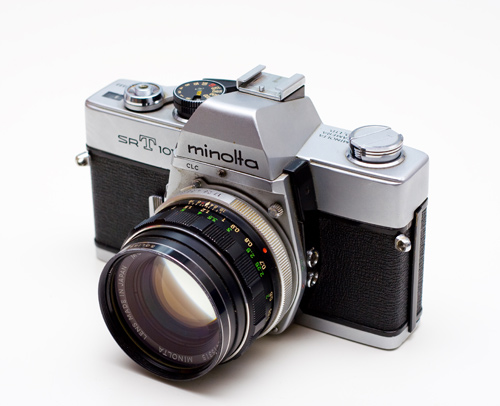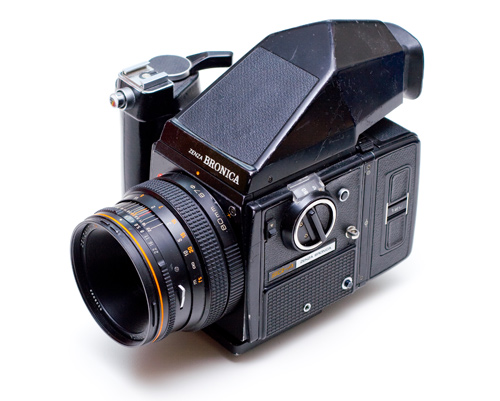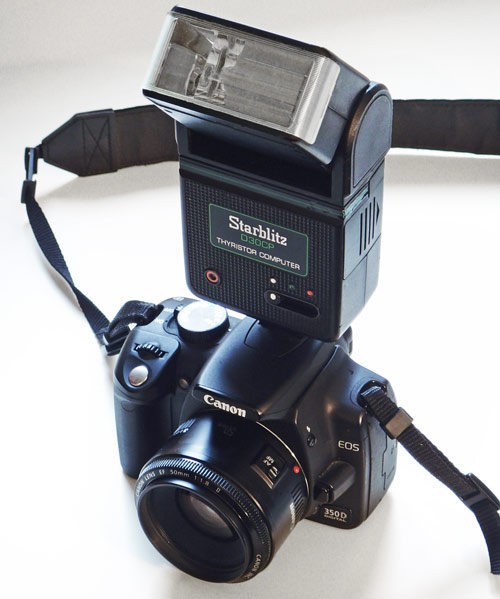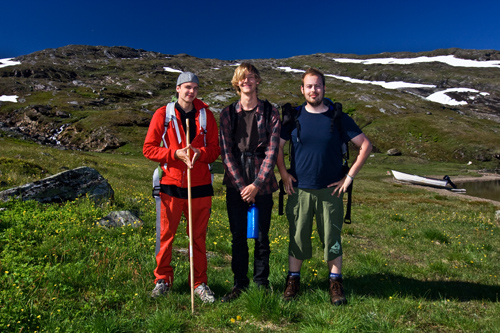There's proper crap, like Holgas, Lomos and Dianas that take rubbish photos, but are cool because the hipsters with keffiyeh's say they are. Then there's the focus of this article, vintage, old-as-your-dad equipment that is dirt cheap, high quality and works outstandingly even today, decades after its manufacture.
A year back, while going through a closet, my mom found her old SLR. She had bought it for her new job as a journalist (which she lost soon thereafter when the newspaper discovered she was a socialist). This was around 25-30 years ago. It was a Minolta SR-T 101, 35mm full frame with a 50mm F/1.7 lens attached. Since I'm the one most into photography in the family, my parents brought it to me.
 Minolta SR-T 101 with 50mm F/1.7 lens
Minolta SR-T 101 with 50mm F/1.7 lensWhat a gem! Owning only a plastic Canon 350D in advance, which cringes under the pressure of a fly landing on it, this by comparison seems solid as bedrock. It seemed to be built all-metal, finding a piece of plastic on this camera was about as hard as finding any metal on the Canon. It's the kind of of camera that doubles as a club if you're fighting off hungry bears.
After I'd wiped of the initial drool from just holding the camera, I peeked into the viewfinder, the HUGE viewfinder. Again, I'm comparing with the 350D, where the tiny claustrophobic finder is barely enough to make out the shapes of what you're shooting, forget about achieving good manual focus in anything but daylight.
In addition to the Minolta being larger in general, the format of this camera is quite simply larger than on the Canon. The Canon has a sensor size of 22.2x14.8mm, while the Minolta is full frame, meaning 35x24mm. In other words, shooting with 50mm lenses on both cameras, the Minolta will quite simply yield photos that are higher and wider, even when the focal length is the same on both cameras. If you want full frame in a digital camera, your cheapest solution is the slightly aged Canon 5D which even today will cost you at least $2000 with a basic lens.
Of course, there are a few cons with this camera. First of all, it's not digital, which is a pretty big issue, at least if you like me never really worked with film prior to the digital age. On the other hand you'll take much more care before shooting each photo on a 36 or 24 frame roll than when you're shooting digital to a 8 GB flash card.
Beyond the non-digital issue, this camera is fully manual, meaning no auto-focus, auto-exposure or the likes. I personally don't mind, I virtually never use auto-exposure with my Canon, though I do use the auto-focus since focusing with such a tiny viewfinder is next to impossible. There is a primitive light-metering system in the camera, but in my particular camera, this is the one thing which hasn't stood the test of time, apparently a quite common issue with this model.
Currently, an SR-T 101 in prime condition runs at about $100 at eBay, if you're not lucky enough to find one tucked away in your parent's closet. A nice alternative to the Minolta is the slightly newer Pentax K1000, which costs roughly the same.
One great thing with these cameras is that they usually come with very fast (Between F/1.4 and 2.0) and super sharp 50mm lenses. If you've never had the pleasure of using a fast 50mm (digital or film), try one out as soon as possible! The distortion-free view coupled with the possibility of shooting shallow depth-of-field photos makes it so much easier to capture great portraits. It's my favourite kind of lens in addition to ultra-wide angles (I've got a Tokina 12-24mm for my Canon 350D).
After the happy re-discovery of the old Minolta 35mm camera, I started checking out all sorts of weird photographic equipment that had been made throughout the 20th century. Having established that when it comes to cameras, film is fun, and old is cool, I eventually decided on getting my feet wet in the world of medium format photography, or in other words, cameras that use much bigger film pieces than 35mm cameras.
The basic advantage of larger (than 35mm) formats is that because the film pieces are bigger, it puts less demands on the quality of the lens as the details captured aren't compressed as much when transferred to the film. Sort of like when you compare an Mp3 file at 32kbps compression with an Mp3 file at 320kbps.
Medium format producers haven't used that as an excuse for making poor quality lenses though, medium gear is typically the realm of professionals, so the equipment is also professional, both in quality and price. Examples of the extremes of both medium and large format cameras can be found in one of my previous articles, Theworld's most extreme photography equipment.
Those professional prices have seemed to collapse entirely in the second-hand market these last years. I suppose it might be the doing of digital medium format cameras being released for sale, but seeing as they tend to run at around $40 000, I'm doubting it's the entire reason. Not everyone can afford digital medium formats, to put it mildly. Whatever the cause, the fact remains: Second hand, non-digital medium format cameras can be had ridiculously cheap nowadays.
I loved the idea of perfectly square photos, of not having to consider whether to shoot horizontal or vertical, of quite simply getting square photos, so I decided to look for a 6x6 inch medium format camera.
 Bronica SQ-A, with 80mm F/2.8 lens
Bronica SQ-A, with 80mm F/2.8 lensThe Bronica SQ camera system quickly emerged as the best candidate for a student of modest means, delivering square photos at a quality rivalling Hasselblad, but at a fraction of the price. The example I got, a Bronica SQ-A, shows clear signs of wear, but works perfectly, and with a total price (including shipping to Norway) of $200, it was an utter bargain. Included in the price was the standard PS 80mm (which equals 50mm in 35mm cameras) F/2.8 lens in great condition and a very handy speed-grip.
Being a so-called system camera, it's possible to exchange all sorts of parts, from the lens and film backs (which holds the 120 film roll) to the matte screen inside the camera and the viewfinder. I'm really only missing a self-exposure timer and a light-meter in this camera, though the latter can be achieved by mounting a metered viewfinder on it. If you want a really sexy medium format, and are willing to forego some mostly minor features in the SQ-system, check out Bronica's older S2A camera instead, it's ridiculously handsome!
Returning to the same closet where the aforementioned Minolta had been found, I discovered another photographic gem. Roughly a decade younger than the Minolta, it's old nonetheless, looks it, and makes a noticeable whine during operation. A Starblitz D30CP flash unit. As no user manual was to be found with it, I have no idea of it's specs, and I'm still having trouble figuring out what the various knobs and adjustments do exactly, so there's I have to fiddle around a good deal when using it.
 Canon 350D with 50mm F/1.8 lens and Starblitz D30CP flash unit attached
Canon 350D with 50mm F/1.8 lens and Starblitz D30CP flash unit attached The public conception of the function of an on-camera flash is that it's only there to illuminate scenes that are too dark to otherwise yield a decent exposure. While this may be true for some types of news photography, drunken party photos and your average snapshots, the allure of flash for photographers seeking technical and compositional qualities is not quite as straight forward.
First of all, the aforementioned function of illuminating dark scenes can be true, given the right circumstances and surroundings. For instance, if you're indoors and you've got a lot of white surfaces (walls and roof), these will be a big help in getting the light from the flash distributed quite evenly throughout the room, which should in turn give a more pleasant, natural-looking light situation than what you might achieve without a flash, when everything just looks red, yellow and blurry. It's rarely a perfect solution, but it sure beats the alternative.
The two first photos in this article are examples of this way of using flash. I put the cameras on a white table in a room with white walls and a white ceiling. By bouncing the light off the ceiling, I was able to "white out" most of the table to achieve an okay isolation. I took care of the rest in post-processing. Off course, to do this, you need a flash which let's you angle the bulb to a desirable position, so built-in, fixed angle flashes like the ones you find on low-end SLRs and pocket cameras aren't an option here.
The other use for on-camera flashes is for doing "fill flash". This is used when there are other light sources illuminating the scene, such as the sun, thereby causing unseemly shadows. To use fill flash, the aperture and shutter speed are adjusted to correctly expose the background, and the flash is fired to lighten the foreground to more the same luminosity (ideally). Below is a rather cheery photo of me and a couple friends shot during a mountain hike last summer. The sun was very bright and shining almost perpendicularly to the angle of the camera. Attached to the camera was the Starblitz unit seen in the photo above.

Once you're finished laughing, notice how well illuminated the photo is, not just in the background. The sun takes care of lighting the surroundings while the flash unit illuminates me and my friends in the foreground. Sure, it's not perfect, but anyone who's shot photos in bright daylight without flash or reflectors should see the advantages involved.
Moreover, anyone who's carried photo equipment over miles and miles of mountains will know how much difference even a lightweight SLR and a small flash unit makes to the weight of the backpack, so bringing more advanced equipment is rarely an option.
Without flash or some kind of reflector to provide extra light, our faces and bodies would've looked like a big lump of darkness, whereas the background would look just like it does here, resulting in an obvious mismatch between the luminosity levels in various parts of the photo. It wouldn't have looked real, it would've looked like a photograph, like the result of inferior equipment trying to capture the same level of light and detail which the human eye is capable off. It's still imperfect compared to observing with your own eyes, though a great deal less so.
To finish off, I suppose I should dispense the moral of this posting. The fact that camera equipment is old does not mean it need be confined to the world of collectors or "toy-camera" enthusiasts (lomography, etc.). Excepting cheap compact cameras and some "toy cameras", photographic gear has usually been manufactured to very high quality standards. Therefore, finding fully usable optics, cameras or other equipment from well into the previous century is no problem at all. Moreover, the sturdy non-digital SLR's of the 60's or 70's are likely to outlast your brand new digital SLR, with all its sensitive electronics.